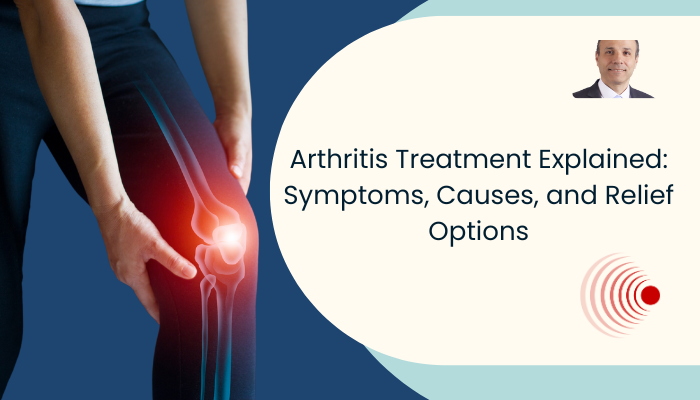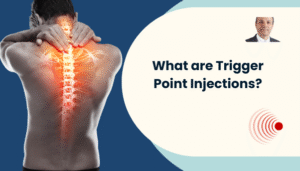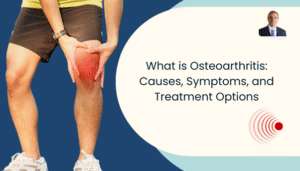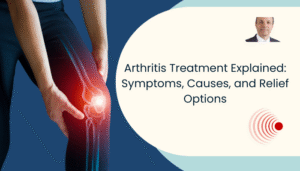Arthritis Treatment Explained: Symptoms, Causes, and Relief Options

Break Free from Joint Pain – Understand, Treat, and Thrive!
Living with arthritis can feel like navigating life with an invisible weight—stiff joints, persistent pain, and everyday tasks that suddenly become overwhelming. Whether it’s the dull ache of osteoarthritis or the flare-ups of rheumatoid arthritis, this condition can adversely impact your mobility and quality of life. Understanding the arthritis symptoms, causes, and available relief options is the first step toward regaining control.
Dr El Toukhy offers compassionate, tailored arthritis treatment plans for individuals suffering from arthritis, combining the latest medical advancements with a patient-first approach to help you move more freely and live more comfortably.
What is Arthritis?
Arthritis is a medical condition characterized by inflammation in one or more joints, leading to pain, stiffness, and reduced mobility. It is not a single disease but a term used to describe a group of over 100 joint-related disorders. While arthritis typically affects older adults, it can also impact individuals of all ages, including children.
The most commonly impacted areas include the knees, hands, hips, and spine. Depending on the type, arthritis can result from wear and tear, autoimmune responses, infections, or underlying diseases. Early diagnosis and appropriate management can significantly slow its progression and enhance quality of life.
What is Knee Arthritis?
Knee arthritis is a condition that indicates the inflammation and degeneration of the knee joint. The knee is formed of bones (femur, tibia, and patella), cartilage, ligaments, and synovial fluid. Cartilage renders a smooth surface for joint motion, and synovial fluid helps lubricate the joint. In arthritis disease, the cartilage wears away, leading to knee pain, swelling, and stiffness.
Common Types of Knee Arthritis
The most common knee arthritis types are mentioned below:
- Osteoarthritis (OA): The most common type, OA is a degenerative joint disease that occurs as a result of wear and tear of cartilage.
- Rheumatoid Arthritis (RA): An autoimmune condition wherein the immune system attacks and damages the joint lining.
- Post-Traumatic Arthritis: Occurs after a knee injury such as ligament damage or fracture.
- Gout and Pseudogout: Caused by crystal accumulation in the joint, leading to sudden and severe inflammation.
Causes and Risk Factors
Some of the common knee arthritis causes are as follows:
- Age (more common in older adults)
- Family history of arthritis
- Previous knee injuries
- Repetitive stress on the joint
- Obesity, which increases pressure on the knees
- Gender (women are more likely to develop RA)
Symptoms of Knee Arthritis
- Persistent pain, especially during or after movement
- Swelling and warmth around the joint
- Stiffness, particularly in the morning or after sitting for long periods
- Decreased range of motion
- Creaking or grinding sensation during movement
How is Arthritis diagnosed?
A thorough physical examination is often supported by diagnostic tools such as:
- X-rays: To check for joint space narrowing and bone spurs
- MRI: For detailed imaging of cartilage and soft tissues
- Blood tests: Especially for diagnosing RA or gout
- Joint aspiration: To analyze synovial fluid.
Treatment for Various Stages of Knee Arthritis
Knee arthritis progresses through four stages, each requiring a tailored treatment approach. Understanding the stage of your arthritis helps guide the most appropriate therapy to preserve mobility and reduce discomfort.
Stage 1: Early or Minor Arthritis
At this stage, there’s minimal cartilage damage and no noticeable narrowing of the joint space. Pain is mild and occasional.
Treatment:
- Lifestyle Modifications: Staying active, maintaining a healthy weight, and avoiding joint overload.
- Exercise Therapy: Low-impact activities like walking, swimming, or cycling to strengthen muscles around the knee.
- Over-the-counter Pain Relief: Occasional use of acetaminophen or NSAIDs like ibuprofen can help.
- Nutritional Support: Some patients benefit from joint supplements like glucosamine and chondroitin.
Stage 2: Mild Arthritis
Cartilage begins to wear down, and bone spurs may form. Symptoms include stiffness after rest and more frequent pain after activity.
Treatment:
- Physical Therapy: Focused on improving joint mechanics, range of motion, and strength.
- Supportive Devices: Shoe inserts, knee braces, or sleeves can offload stress from the knee.
- Viscosupplementation: Injections of hyaluronic acid may improve joint lubrication.
- Activity Adjustment: Limiting high-impact exercises that stress the knees.
Stage 3: Moderate Arthritis
Significant cartilage erosion leads to joint space narrowing and more persistent pain, even during rest.
Treatment:
- Corticosteroid Injections: Provide temporary relief from inflammation and swelling.
- Platelet-rich plasma (PRP): Regenerative therapy using components of your own blood to eliminate inflammation and promote tissue repair.
- Assistive Aids: Use of a cane or walker during flare-ups.
- Anti-inflammatory Medications: Stronger prescription NSAIDs may be needed to manage pain.
Stage 4: Severe Arthritis
Cartilage is almost completely gone, and bones may rub directly against each other. Daily activities become challenging, and pain is constant.
Stage 4 Arthritis Knee Treatment:
- Total Knee Replacement Surgery (TKR): This is the most definitive treatment, replacing damaged joint surfaces with artificial implants.
- Partial Knee Replacement (PKR): Considered when only one compartment of the knee is affected.
- Stem Cell Therapy: May be an option for selected patients, although results vary.
- Comprehensive Rehabilitation: Post-surgical physical therapy is essential for regaining strength and mobility
Treatment of Various Types of Arthritis
Each type of arthritis has unique causes and treatment protocols. Here’s how common types are managed:
1. Osteoarthritis (OA)
Caused by wear and tear of cartilage over time.
Treatment:
- Exercise and weight loss
- NSAIDs and pain relievers
- Hyaluronic acid injections
- Joint replacement in advanced cases
2. Rheumatoid Arthritis (RA)
An autoimmune disease where the body attacks joint linings.
Rheumatoid Arthritis treatment involves:
- DMARDs (e.g., Methotrexate): To slow disease progression
- Biologic Therapies: Target specific immune responses (e.g., TNF inhibitors)
- Steroids: For flare-up management
- Physical therapy: To maintain joint function
3. Psoriatic Arthritis
Linked with psoriasis, affecting both skin and joints.
Psoriasis Arthritis treatment may involve the following course of action:
- Biologic agents (e.g., IL-17 and TNF blockers)
- Topical treatments for skin symptoms
- NSAIDs and DMARDs
- Lifestyle changes, including anti-inflammatory diets
4. Ankylosing Spondylitis
Inflammation majorly affecting the spine and sacroiliac joints.
Treatment:
- NSAIDs as first-line treatment
- Biologic agents (especially TNF inhibitors)
- Physical therapy focused on spinal posture and flexibility
- Lifestyle: Daily stretching and posture correction exercises
5. Gout
A type of inflammatory arthritis occuring due to uric acid crystal buildup.
Treatment:
- Medications to reduce uric acid (e.g., allopurinol)
- NSAIDs and colchicine for acute attacks
- Dietary adjustments to avoid purine-rich foods (red meat, shellfish, alcohol)
- Hydration and weight control
6. Reactive Arthritis
Occurs as a reaction to infections elsewhere in the body.
Reactive Arthritis treatment may include the following:
- Antibiotics (if infection is still present)
- NSAIDs to reduce inflammation
- Corticosteroids for severe joint swelling
- Physical therapy for joint rehabilitation
7. Juvenile Idiopathic Arthritis (JIA)
Affects children and may involve systemic symptoms.
Treatment:
- NSAIDs and corticosteroids
- Biologics or DMARDs for severe cases
- Occupational and physical therapy to support development
- Regular pediatric rheumatology follow-up
FAQs
OA, or osteoarthritis, is a degenerative disease that causes cartilage in the joints to wear away, resulting in stiffness and pain.
Common osteoarthritis symptoms include joint pain, stiffness, tenderness, and loss of flexibility.
Osteoarthritis is primarily “wear and tear,” while rheumatoid arthritis is an autoimmune inflammatory disease.
Common osteoarthritis treatments include exercise, physical therapy, pain relievers (osteoarthritis medicine), and sometimes surgery.
Specific exercises for knee osteoarthritis are intended to build muscle strength and improve knee flexibility.
Yes, cervical osteoarthritis, affecting the neck joints, is a common cause of neck pain.
While symptoms of knee osteoarthritis can be effectively managed, there isn’t a known “cure.” Instead, the focus is on treating osteoarthritis to relieve pain.
The general treatment for osteoarthritis aims to reduce pain and improve joint function through various methods.
Looking for well-guided arthritis treatment in Dubai? Consult Dr El Toukhy
Dr El Toukhy is a highly experienced orthopedic specialist in Dubai, known for his expertise in managing complex arthritis cases using both conservative and surgical methods. His patient-centric approach ensures a customized treatment plan tailored to your lifestyle and condition severity.
Whether you’re in the early stages of knee arthritis or considering advanced joint replacement surgery, Dr El Toukhy offers comprehensive care with excellent outcomes.
Book a consultation today to take the first step toward treating arthritis, pain relief, and improved mobility.
Related Post

What are trigger point injections?
What are trigger point injections? Sometimes, muscle pain can be

What is Osteoarthritis: Causes, Symptoms, and Treatment Options
What is Osteoarthritis: Causes, Symptoms, and Treatment Options As we

Arthritis Treatment Explained: Symptoms, Causes, and Relief Options
Arthritis Treatment Explained: Symptoms, Causes, and Relief Options Break Free

